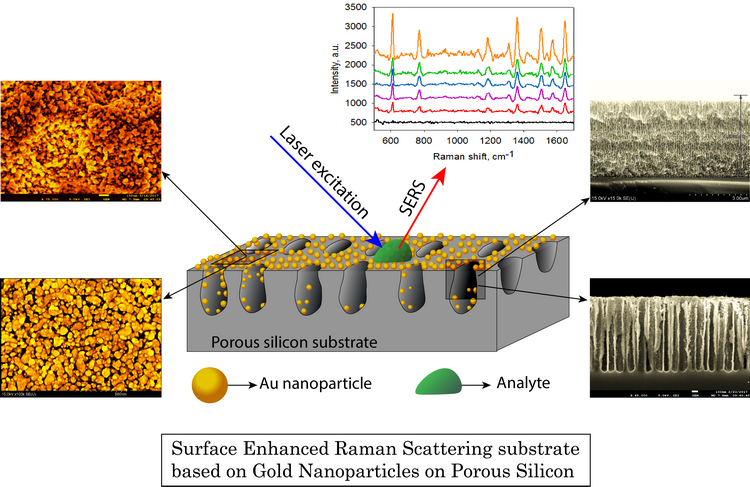Plasmonic nanostructures based on gold nanoparticles on porous silicon
Prepared by: Sergey Zavatski, master’s student of 7М2701 group, specialty 1-41 80 01 "Solid-state electronics, radioelectronic components, micro- and nanoelectronics, devices based on quantum effects ", electronic engineer of R&D Laboratory 4.3 BSUIR "Materials and components of nanoelectronics".
Supervisor: Hanna Bandarenka, Ph.D. in Engineering Science, deputy pro-rector of research BSUIR.
Methods for the formation of plasmonic nanostructures based on gold (Au) and porous silicon (PS) by chemical deposition of Au from aqueous solutions have been developed. The obtained structures include predominantly spherical Au nanoparticles with a diameter of several tens to several hundred nanometers, distributed over the surface of meso- or macro-PS. It is assumed that the deposition of Au on PS proceeds according to layer-plus-island mechanism of growth.
It was shown than Au/PS nanostructures exhibit surface enhanced Raman scattering (SERS) effect. The range corresponding to the surface plasmon resonance determined for these structures from the reflection spectra is located in the spectral interval from 480 to 485 nm. It was found that Raman scattering enhancement by plasmonic nanostructures depends on porosity of PS and Au deposition time. Better enhancement (more than twice) was achieved for Au/macro-PS nanostructures. However, such parameters as porosity of PS and Au deposition time should still be carefully optimized in order to obtain better Raman amplification.
Au/PS nanostructures can be used in SERS spectroscopy, which allows to detect, identify and study trace amounts of substances in materials science as well as in biomedicine, ecology, food industry, forensics and many others.
Supervisor: Hanna Bandarenka, Ph.D. in Engineering Science, deputy pro-rector of research BSUIR.
Methods for the formation of plasmonic nanostructures based on gold (Au) and porous silicon (PS) by chemical deposition of Au from aqueous solutions have been developed. The obtained structures include predominantly spherical Au nanoparticles with a diameter of several tens to several hundred nanometers, distributed over the surface of meso- or macro-PS. It is assumed that the deposition of Au on PS proceeds according to layer-plus-island mechanism of growth.
It was shown than Au/PS nanostructures exhibit surface enhanced Raman scattering (SERS) effect. The range corresponding to the surface plasmon resonance determined for these structures from the reflection spectra is located in the spectral interval from 480 to 485 nm. It was found that Raman scattering enhancement by plasmonic nanostructures depends on porosity of PS and Au deposition time. Better enhancement (more than twice) was achieved for Au/macro-PS nanostructures. However, such parameters as porosity of PS and Au deposition time should still be carefully optimized in order to obtain better Raman amplification.
Au/PS nanostructures can be used in SERS spectroscopy, which allows to detect, identify and study trace amounts of substances in materials science as well as in biomedicine, ecology, food industry, forensics and many others.

